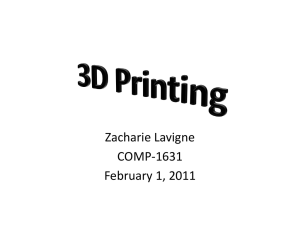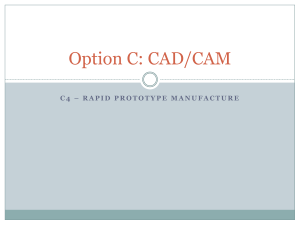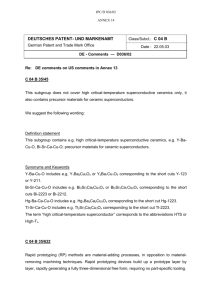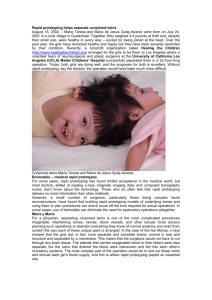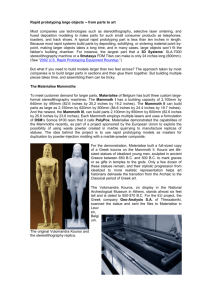The purpose of this research is finding out optimum rapid
advertisement
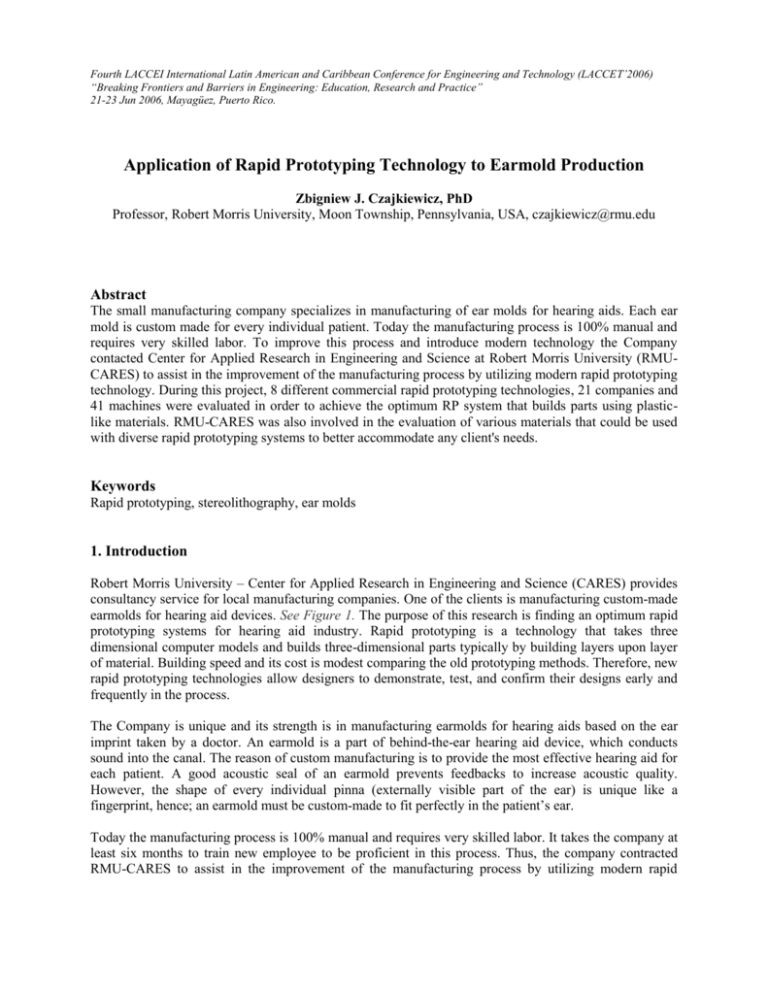
Fourth LACCEI International Latin American and Caribbean Conference for Engineering and Technology (LACCET’2006) “Breaking Frontiers and Barriers in Engineering: Education, Research and Practice” 21-23 Jun 2006, Mayagüez, Puerto Rico. Application of Rapid Prototyping Technology to Earmold Production Zbigniew J. Czajkiewicz, PhD Professor, Robert Morris University, Moon Township, Pennsylvania, USA, czajkiewicz@rmu.edu Abstract The small manufacturing company specializes in manufacturing of ear molds for hearing aids. Each ear mold is custom made for every individual patient. Today the manufacturing process is 100% manual and requires very skilled labor. To improve this process and introduce modern technology the Company contacted Center for Applied Research in Engineering and Science at Robert Morris University (RMUCARES) to assist in the improvement of the manufacturing process by utilizing modern rapid prototyping technology. During this project, 8 different commercial rapid prototyping technologies, 21 companies and 41 machines were evaluated in order to achieve the optimum RP system that builds parts using plasticlike materials. RMU-CARES was also involved in the evaluation of various materials that could be used with diverse rapid prototyping systems to better accommodate any client's needs. Keywords Rapid prototyping, stereolithography, ear molds 1. Introduction Robert Morris University – Center for Applied Research in Engineering and Science (CARES) provides consultancy service for local manufacturing companies. One of the clients is manufacturing custom-made earmolds for hearing aid devices. See Figure 1. The purpose of this research is finding an optimum rapid prototyping systems for hearing aid industry. Rapid prototyping is a technology that takes three dimensional computer models and builds three-dimensional parts typically by building layers upon layer of material. Building speed and its cost is modest comparing the old prototyping methods. Therefore, new rapid prototyping technologies allow designers to demonstrate, test, and confirm their designs early and frequently in the process. The Company is unique and its strength is in manufacturing earmolds for hearing aids based on the ear imprint taken by a doctor. An earmold is a part of behind-the-ear hearing aid device, which conducts sound into the canal. The reason of custom manufacturing is to provide the most effective hearing aid for each patient. A good acoustic seal of an earmold prevents feedbacks to increase acoustic quality. However, the shape of every individual pinna (externally visible part of the ear) is unique like a fingerprint, hence; an earmold must be custom-made to fit perfectly in the patient’s ear. Today the manufacturing process is 100% manual and requires very skilled labor. It takes the company at least six months to train new employee to be proficient in this process. Thus, the company contracted RMU-CARES to assist in the improvement of the manufacturing process by utilizing modern rapid prototyping technology. Rapid prototyping permits building numerous custom designed earmolds for different patients at a time. Figure 1: Behind-the-ear hearing aid device (left) and earmold (right). Copyrights GNU FDL, user Nordelch June 2005 One of the major goals of this project was to prove that technology and the process can be implemented in regular production to save cost, improve quality and consistency of the production. It can also assure repeatability of the process, which is not possible with manual process. RMU-CARES was involved in the evaluation of various materials that could be used with diverse rapid prototyping systems to better accommodate any client's needs. The primary focus of this project is on RP systems that build parts using plastic-like materials. During this project, 8 different commercial rapid prototyping technologies, 21 companies and 41 machines were evaluated in order to achieve the optimum RP system and the material. See table 1. Table 1: Rapid Prototyping Machine Manufacturers by Technologies TECHNOLOGY COMPANY MODEL SL, SLA 3D SYSTEMS VIPER HA SLA VIPER SLA SLA 5000 SLA 7000 AUTOSTRADE E-DARTS CMET RAPID MASTER 3000 RAPID MASTER 6000 DENKEN SOLIDJET SJ-200P FOCKE UND SCHWARZE FS-REALIZER SLT NEXT FACTORY DIGITALWAX 010 SONY SCS-6000/6000D SCS-8100/8100D SCS-9000/9000D UNIRAPID SP-1502 URM-HP301 LS, SLS 3D SYTEMS SINTERSTATION HIQ SINTERSTATION PRO EOS EOSINT P 380 EOSINT P 700 SPEED PART DIMENSION FDM STRATASYS SHEET LAMINATION 3D SYSTEMS CUBIC KIRACORP 3D PRINTING SOLIDIMENSION Z-CORP DLP POLYJET ENVISIONTEC STRATASYS/OBJET MJM 3D SYSTEMS SPEED PART RP3 BST SST PRODIGY VANTAGE i/S/SE TITAN MAXUM INVISION LD-3D LOM-1015 LOM-230H KSC-50N PLT-A4 SD 300 Z310 Z510 Z810 PERFACTORY EDEN 260 EDEN 333 THERMOJET INVISION HR-3D INVISION SR-3D 2. Process Descriptions 2.1. Description of the Current Process Imprint of patient ear is taken by a doctor and sent to the earmold manufacturer Laboratory technicians prepare a mold using the patient’s imprint The part is produced by the solidification of liquid acrylic or silicone poured into the mold. The material is selected in accordance with the pinna’s softness. Generally, a soft pinna requires a rigid earmold, and a hard pinna requires vice versa The part is trimmed, cleaned and ready for use Figure 2: Regular style occluding earmold (left). Regular style earmold with tubing (right) 2.2. Description of the New Process Imprint of patient ear is taken by a doctor and sent to the earmold manufacturer Engineer scans the imprint using 3-D scanner Using special 3-D design software the part is then designed and evaluated on the computer After design is completed, set of earmolds file is downloaded to the rapid prototyping machine where it is produced - again eliminating the manual process. Finally, after the parts are completed, they are trimmed, cleaned, and ready for use. 2.3. Rapid Prototyping Tools To Be Used In The Manufacturing Process 2.3.1. 3-D Scanner A three dimensional scanner is used to digitize the imprint, so that the captured data is converted typically into a CAD/CAM file. 2.3.2. 3-D Design Software CAD/CAM (Computer-Aided-Design and Computer-Aided-Manufacturing) software allows designers to create or improve an existing model in three dimensions. The following software is the most commonly used in three-dimensional modeling: Alibre, Lightscape Mechanical Desktop, ArchiCAD, ProE, AutoCAD, CADKey, Rhinoceros 3D Modeling, I-Deas, SolidDesign, Inventor, SolidEdge, IronCAD, SolidWorks, Think3, 3D Studio Max, Unigraphics 2.3.3. Rapid prototyping machine Designed models will be converted first typically to STL format (.stl extension), and then will be exported to the RP machine. 50-70 different earmolds can be built at a time in between 3 to 8 hours according to the machine’s technology and type. 3. Concerns for Rapid Prototyping Utilization in the Process Utilization of rapid prototyping in hearing aid industry is a new approach. A small number of companies use this technology for earmold manufacturing. Terry Wohlers, who is an industry analyst and publisher of the Wohlers Report, states, “People who are hearing-impaired also benefit from rapid manufacturing. Companies including Siemens (Piscataway, NJ), Phonak (Warrenville, IL), and Widex (Long Island, NY) are using RP systems to manufacture custom-fit, in-the-ear hearing aids. Siemens and Phonak are using laser sintering, while Widex is using stereolithography” (Wohlers 2003). The client has concerns in regard to appearance and quality of earmolds made with both laser sintering and stereolithography. It has been observed that the products made with stereolithography may be brittle for finishing and long-term use. Another observed problem is that the stereolithography material ages and changes its color over time. Neil Hopkinson, a lecturer in the Rapid Manufacturing Research Group (RMRG) at Loughborough University (Leicestershire, England) indicates, “cured resins tend to cure over time, so the mechanical properties can change. If that can be overcome, there is a good future for the curing system” (Kincade 2005). On the other hand, products made with laser sintering do not have aging problem, nevertheless, they are not clear. The client opposed the idea of producing non-aesthetical earmolds. In fact, many endusers have aesthetical concerns and they do not want to expose their hearing problems; hence, skin color earmolds are preferable. However, beige material does not match most of the people’s skin color. Therefore, clear materials are in high demand and used in earmolds production. Engineers of the client emphasized that the product has to keep its clear and colorless state over time regardless of the type of exposure e.g. sun. The last important issue about material is that most RP materials are skin-irritant or allergenic. However, the product must be biocompatible. 4. Scope of the Research The initial research conducted during this project was to determine all existing commercial RP technologies. The necessity of product clearness eliminated at once systems that build metal parts only; hence, it drove the research into plastics and plastic-like RP materials. 4.1. Possible RP Technologies and Materials 4.1.1. Stereolithography (SL, SLATM): Stereolithography produces three dimensional parts one layer at a time using a laser to harden UV-curable resin. The laser beam traces cross sectional slice information of the 3D CAD data onto the surface of a container of liquid photopolymer. Stereolithography uses materials that solidify very quickly; therefore, a second layer can be built onto the first layer. See Figure 3. Materials used: Liquid photo reactive UVcurable resin - epoxies, acrylates. Figure 3 Stereolithography. Copyrights 2005 Materialise Technologielaan 4.1.2. Laser sintering: (LS, SLSTM) Laser Sintering is creating objects, layer-by-layer, by using heat of a CO2 laser to sinter or fuse ceramic, metal, or plastic powders. The powder in the build chamber is used as a support for part during the process. See Figure 4. Materials: Powdered materials – polycarbonate, nylon, glass-filled nylon Figure 4: Laser Sintering. Copyrights 2005 Materialise Technologielaan 4.1.3. Fused Deposition Modeling: (FDMTM) This process uses molten plastics to build a three dimensional part. A nozzle traces the parts cross sectional geometry layer-by-layer. The material is heated up to only one degree below the melting point. Once the material is extruded, it solidifies quickly at contact with previous layer. See Figure 5. Materials: Plastics – ABS, polycarbonate Figure 5: Fused Deposition Modeling 4.1.4. Laminated Object Manufacturing (LOMTM), or Sheet lamination The process uses a CO2 laser to create cross-section of a three dimensional object from layers of a special paper. A heated roller is used to melt the coating on the paper layer to adhere to the previous layer. The CO2 laser cuts the outline of the cross-sectional pattern as each new layer is created and bonds layer by layer until a 3-D model is produced. See Figure 6. Materials: Special paper or plastic sheets and toner rigid polyvinyl chloride compound (Solidimension) Figure 6: Sheet Lamination. © Milwaukee School of Engineering 4.1.5. Three Dimensional Printing 3D printing is similar to the SLS method except instead of using a laser to sinter material together, a print head dispenses a solution to bind the powder together. See Figure 7. Materials: Plaster or starch. Infiltrants such as wax, cyanacrylate and epoxy are used after the part is printed. Figure 7: Three Dimensional Printing. Copyright © 2006 Cyon Research Corporation 4.1.6. Digital Light Processing: This method of creating solid parts has similarities with stereolithograpy. However, this new photopolymerization process is based on layer-by-layer Mask Projection, using DLPTM (Digital Light Processing) Technology See Figure 8. provided by Texas Instruments as a source of light (Figure 9) instead of laser (like the stereolithography). Materials: Liquid photopolymer sensitive to visible light Hybrid acrylate, methacrylates, expoxydes, nanoparticle filled materials and compounds Figure 8: Digital Light Processing. Copyright 2005 CRDM UK Figure 9: DLP, light source Copyright 2006 Texas Instruments 4.1.7. PolyJet (PJET): The technology has significant similarities with stereolithography. The difference is that photosensitive material, which is in solid state (unlike the liquid SL material), is heated up, and jetted out small droplets onto the build tray in a semi-viscous state. Once it is jetted, it is cured by UV lights and turns into a solid layer. See Figure 10. Materials: Solid Acrylate-based photopolymer resin. Figure 10: PolyJet: Copyright 2005 Object Geometries Ltd 4.1.8. Multi-Jet Modeling (MJM): The process uses a print head that consists of linear arranged jets. The jets dispense thermopolymer material on the build tray with each pass along an X-axis, building layer upon layer of material that solidifies into the physical prototype. See Figure 11. Materials: Acrylic photopolymer Figure 11: Multi-Jet Modeling. Copyright 2006 Cyon Research Corporation 4.2. Possible RP Materials RMU-CARES focused on clear RP materials. Initially, all possible clear materials, which could be used in these eight RP technologies, were identified. The research showed that laser sintering, sheet lamination and three-dimensional printing technologies do not currently have clear/transparent object creating capability. Some stereolithography resins and some other plastic-like RP materials have met the criteria. Therefore, stereolithography, PolyJet and DLP were considered as target technologies. Additionally, Fused Deposition ModelingTM (FDM) and Multi Jet ModelingTM (MJM) systems can also build translucent parts using plastics such as ABS (Acrylonitrile Butadiene Styrene) and Polycarbonate, and Acrylic Photopolymer respectively. Sample STL files of earmolds were sent to machine manufacturers to make sample parts to compare parts’ accuracy, clearness and any possible tint. All companies were asked to build these parts using their most clear material. Earmold samples were evaluated in order to determine most promising systems and materials. 4.2.1. FDM Both Stratasys and Dimension have successful rapid prototyping machines employing FDM technology. The machines are suitable for building accurate and durable parts. Their simplicity of use and affordable prices would have positioned them above all if they were able to create clear objects. Dimension 3D Group which is a member of Stratasys Inc., provides the cheapest RP system in North America. Both BST and SST systems use FDM technology and have price tags under $25,000 and $30,000 respectively. The ABS, which is used in FDM systems, has remarkable resemblances with those used in plastic injection molding machines. Todd Grimm, a rapid prototyping expert and president of T.A. Grimm & Associates, indicates, “Users report that the ABS prototypes demonstrate 60–80% of the strength of injection molded ABS. Other properties, such as thermal and chemical resistance, also approach or equal those of injection molded parts. This makes ABS a widely used material for functional applications” (Grimm 2003). In fact, clear ABS materials are available in this field. Attractive system prices in comparison to other technologies caused CARES to investigate possible use of clear ABS materials in FDM technology. The idea was that fine-tuning the material’s compounds and additional machine setups could make possible the use of FDM in order to build clear ABS parts. However, the Stratasys engineers informed CARES that it had been tested before and noticed that the temperature at extrusion point made the material lose its clearness. Theoretically, it is possible to produce clear parts in this system using clear ABS, nevertheless, high costs of research activities for both machine and material manufacturers, and limited market demand for clear parts ruled out this option. CARES received sample parts from Stratasys with two different materials: ABS and polycarbonate (PC). The ABS parts were far from being translucent. It was noticed that they are opaque white. The PC parts provided very low translucency with glittery white color. Subsequently, it was decided to eliminate the FDM technology from further consideration due to unsatisfactory clearness of the sample parts. 4.2.2. MJM Parts made with VisiJet SR-200 in 3D Systems’ Invision SR-3D machine did not meet the transparency expectations. The parts were translucent rather than being transparent. 4.2.3. PolyJet Objet Geometries of Israel patented its PolyJetTM in 2000. Objet’s PolyJet systems are exclusively distributed by STRATASYS Inc. in North America. High accuracy and good finish was observed in sample parts made with Eden 260 using FullCure 720 material. The transparency of parts was satisfactory; nevertheless, extreme yellow tint did not pass the client’s quality expectations. 4.2.4. Envision Tech - DLPTM Digital Light Process DLP® technology of Texas Instruments has been used principally in TVs and projectors. Envision Tech implemented DLP to its Perfactory® rapid prototyping machine as a source of light instead of laser. Perfactory RP machine has recently found utilization among the hearing aid industry with its significant low investment cost comparing to other stereolithography systems. The material used by Perfactory was acryl R-5. The sample parts met the transparency expectations. However, their strong beige tint was a negative aspect. Besides, bubbles were observed in the parts. In conclusion, Perfactory could not be an option for the client. 4.2.5. Stereolithography Although there are several stereolithography machine manufacturers in the world, CARES had to consider their technical support ability in the US. Because of the good support capabilities, only Sony and 3D Systems were considered further. The following companies supply stereolithography resins: 4.2.5.1. DSM – Somos DSM – Somos is a part of DSM group (Netherlands). DSM – Somos has been manufacturing stereolithography resins since 1992. The company has 11 different SL resin types in its product range for diverse stereolithography applications. The excellent clearness of WaterClear 10120 and WaterShed 11120 caught CARES’ attention immediately, so CARES contacted the company and asked for sample earmolds. It was noticed that there is a slight green tint in 11120 and decided to focus on 10120. However, DSM Somos Senior Account Manager stated that the 10120 resin does not have the green tint, but it is sensitive to atmospheric moisture and liquid water. This sensitivity can be somewhat reduced by increasing the exposure, but the parts may then look a little yellow. Nevertheless, it is possible to reduce the green tint in 11120 by fine-tuning the machine’s setups. As it is mentioned in the description of the current process, hard pinna requires soft earmold. DSM – Somos has a promising product for this purpose. The company launched the first flexible/elastic stereolithography material ULM 17720 in 2006. Currently, 17720 comes in black color only due to market demand. However, CARES was informed by SOMOS engineers that clear type of the material was successfully used in early stages of the development phase. 4.2.5.2 Dreve Otoplastik GmbH Dreve (Germany) has been manufacturing earmold materials since 1965. The company launched its first stereolithography resin Fototec SL in 2003 for earmold manufacturing. Fototec SL product range has various colors including clear/transparent. The material is optimized to use with 3D Systems Viper series. Upon 3D Systems’ suggestion, CARES asked Dreve to build sample parts. The results were quite surprising. It was expected to see better parts in clearness than Somos because, Dreve is more specialized and experienced in earmold material manufacturing. However, the sample earmolds had yellow/beige tint and less transparency in comparison to Somos. The tint could have been definitely acceptable for those who have white skin color. Nevertheless, despite its prominence, Dreve was eliminated by the client. 4.2.5.3. American Dye Source, Inc. The Canadian company manufactures stereolithography resins with different specifications. The company recommended their G-4 Tuxedo resin indicating that it will meet the client’s expectations. However, it was observed that the sample parts have light yellow color. The company’s engineers informed CARES that they do not have colorless stereolithography resins for the moment. 4.2.5.4. Huntsman Advanced Materials Americas, Inc. Huntsman Advanced Materials Americas Inc is a part of Huntsman Corporation that is a global manufacturer and marketer of various chemical products. The company recommended LLS-71620 stereolithography material. According to the information provided by the company, the material is suitable for medical use. The transparency of sample parts was satisfactory. Nevertheless, a subtle yellow tint was observed in the sample parts. 5. Selection and Conclusion CARES was aware that wrong recommendation of the RP system and material type could cause the client to lose a serious amount of money and valuable time. Furthermore, it could damage the client’s excellent reputation in the marketplace. Therefore, every single technology, machine and material type was evaluated through consultation with the client’s experienced engineers. In conclusion, stereolithography was selected as technology due to its ability to build clear parts and high accuracy. Additionally, various types of materials with diverse features and rapid developments in this field had major influence on this decision. DSM – Somos was selected as material manufacturer due to its WaterShed 11120’s superior quality features in comparison to other manufacturers. Another reason for this choice was the company’s ULM 17720 flexible material. Future use of the clear type of this material could be possible in earmold manufacturing. There were two alternatives among stereolithography machines to choose from; Sony SCS-6000 and 3D Systems Viper HA SLA Dual Vat System. Both machines provide high accuracy in part building. Nevertheless, Viper has an advantage with dual vat system that makes possible to produce parts with different materials. Dual vat system cannot be ignored, knowing that elastic materials can be used in near future. 6. References Grimm, Todd (2003). “Fused Deposition Modeling: A Technology Evaluation”. Time CompressionTechnologies April 2003, 11/2 Kincade, Kathy (2005). “Rapid prototyping evolves into custom manufacturing”. Laser Focus World May, 2005 Wohlers, Terry (2003). “Words of Wisdom: Rapid manufacturing on the horizon”. Plastics Machinery & Auxiliaries, October 2003. Authorization and Disclaimer Authors authorize LACCEI to publish the papers in the conference proceedings. Neither LACCEI nor the editors are responsible either for the content or for the implications of what is expressed in the paper.
